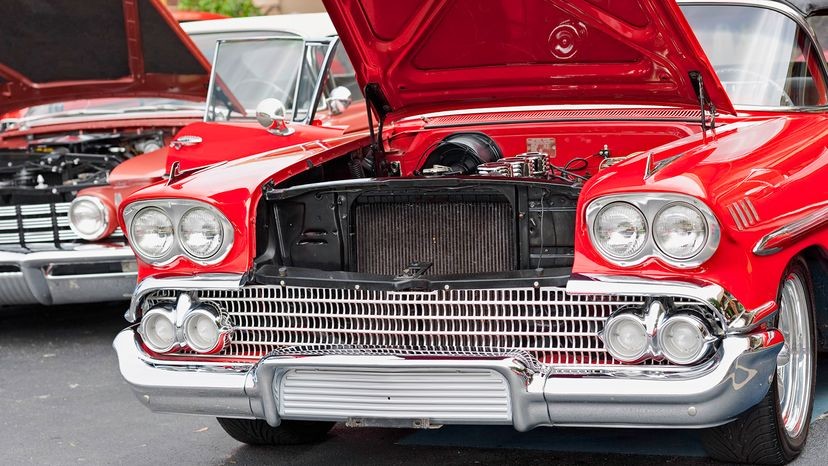Car modification is a popular hobby and a way for enthusiasts to personalize their vehicles, enhance performance, or simply improve aesthetics. Whether you’re aiming for a subtle cosmetic upgrade or a significant performance boost, understanding the landscape of car modifications is crucial. This guide will walk you through popular car modifications, legal considerations, and essential factors to keep in mind before you start wrenching.
Popular Car Modifications: Legal and Performance Enhancing
Modifying your car can range from simple bolt-on accessories to complex engine overhauls. Some modifications are purely for looks, while others can drastically change how your car performs. Let’s explore some common modifications, starting with those that are generally legal and performance-oriented.
1. Suspension Upgrades: Handling and Ride Comfort
Upgrading your car’s suspension system is a widely accepted modification, often praised for improving handling and ride quality. Aftermarket suspension systems offer a range of adjustability and performance benefits compared to factory setups.
A collection of aftermarket car suspension components, illustrating the variety of parts available for upgrading vehicle handling.
Benefits of Suspension Upgrades:
- Improved Handling: Stiffer springs and adjustable dampers can reduce body roll in corners and enhance responsiveness.
- Adjustable Ride Height: Lowering springs or coilover systems allow you to adjust the car’s ride height for a sportier stance and improved aerodynamics. (Note: Be mindful of legal ride height limits in your region).
- Enhanced Ride Comfort: Depending on the system chosen, some aftermarket suspensions can actually improve ride comfort by better absorbing bumps and vibrations.
- Performance Tuning: For track enthusiasts, high-end suspension systems can be finely tuned to optimize performance for specific driving conditions and styles.
Legality: As long as you adhere to your local regulations regarding vehicle height and suspension geometry, suspension modifications are generally legal. Always check your state or local laws concerning ride height adjustments to avoid any legal issues.
2. Turbochargers and Superchargers: Power Boost
For those seeking more power, adding a turbocharger or supercharger is a popular and effective modification. These forced induction systems increase engine power by compressing and forcing more air into the engine.
How Turbochargers and Superchargers Work:
- Turbochargers: Utilize exhaust gases to spin a turbine, which in turn drives a compressor to force air into the engine.
- Superchargers: Are mechanically driven by the engine’s crankshaft, directly compressing air and feeding it into the intake manifold.
Legality and Considerations: Turbochargers and superchargers are legal in many regions, provided they do not cause your vehicle to fail emissions tests or safety inspections. Crucially, ensure any forced induction modification doesn’t tamper with your car’s emissions control system. In areas with strict emissions standards, like California, ensure your modifications are certified and comply with smog check requirements. Modifying your emissions system is illegal and can result in hefty fines.
3. Sport Seats: Comfort, Support, and Style
Upgrading to sport seats is a modification that enhances both the look and feel of your car’s interior. Sport seats can offer improved comfort, better support during spirited driving, and a more stylish aesthetic.
A set of sporty aftermarket seats, highlighting their enhanced side support and stylish design which can improve driving posture and comfort.
Important Considerations for Sport Seats:
- Street Legality: While sport seats themselves are generally legal, racing seats designed for harnesses are typically not street legal if they replace factory seatbelts. Ensure any sport seats you install are compatible with your factory seatbelts and do not disable airbags.
- Safety: Some racing seat manufacturers explicitly state their seats are not for street use, primarily because they are designed for use with racing harnesses, which are not legal replacements for standard seatbelts on public roads.
- Compatibility: Choose sport seats from reputable manufacturers like Recaro that are specifically designed and certified for street use.
4. Paint Jobs and Vinyl Wraps: Personalization and Aesthetics
A new paint job or vinyl wrap is a purely cosmetic modification that can dramatically change your car’s appearance. From vibrant colors to custom designs, the possibilities are vast.
Legal Aspects of Paint and Wraps:
- Color and Design Freedom: Generally, you have broad freedom in choosing your car’s color and design. However, avoid paint schemes or wraps that mimic police or emergency vehicles, as this is illegal and can lead to serious legal repercussions.
- DIY Painting Considerations: If you opt for a DIY paint job, be aware of local environmental regulations regarding paint fumes and chemical disposal. Professional paint jobs can be expensive but ensure quality and compliance with environmental standards.
5. Window Tint: Style and Privacy
Window tint is a popular modification for enhancing privacy, reducing heat and glare, and improving the car’s overall look. However, window tint laws are quite stringent and vary significantly by region.
Window Tint Legality:
- Varying State Laws: Window tint laws are state-specific and often regulate the darkness and reflectivity of tint. Some states have strict limitations, especially on front and side windows.
- Visible Light Transmission (VLT): Tint darkness is measured by VLT percentage, indicating how much light can pass through. Most states specify permissible VLT ranges.
- Reflective Tint: Some states restrict or prohibit reflective window tints.
- Medical Exemptions: Some states offer medical exemptions for darker tints with documented medical conditions.
Before tinting your windows, thoroughly research and understand your local window tint laws to ensure compliance and avoid fines or the need to remove the tint.
Illegal Car Modifications: What to Avoid
While many modifications are legal and enhance your car, some are strictly prohibited due to safety concerns or environmental regulations. It’s crucial to be aware of these illegal modifications to avoid legal trouble and ensure road safety.
1. Nitrous Oxide: Street Racing Hazard
Nitrous oxide (N2O), often referred to as NOS, is a performance-enhancing modification that is frequently depicted in street racing culture. While nitrous oxide can provide a significant power boost, its legality for street use is highly restricted.
A nitrous oxide system installed in a vehicle, demonstrating the components that deliver a power boost but are often restricted for street use due to safety concerns.
Nitrous Oxide Legality:
- Disabled Systems: In many jurisdictions, while it’s legal to install a nitrous oxide system, it must be disabled for street use. This typically means the nitrous bottle cannot be connected or active while driving on public roads.
- Safety Concerns: The use of nitrous oxide is often associated with unsafe driving practices, contributing to its legal restrictions.
- Proof of Non-Use: Even if you have a nitrous system installed, be prepared to demonstrate to law enforcement that it is not in use if you are pulled over.
2. Underbody Neon Lights: Distraction and Impersonation Risks
Underbody neon lights, while once a popular aesthetic modification, are often illegal due to their potential to distract other drivers and their association with impersonating law enforcement.
Legality of Underbody Neon Lights:
- Color Restrictions: Many regions prohibit blue or red neon lights as they can be mistaken for police vehicle lights, leading to impersonation charges.
- Distraction Hazard: Some areas ban neon lights altogether due to concerns about distracting other drivers and causing safety hazards, especially at night.
- Exterior Lighting Regulations: Blanket bans on altering exterior vehicle lighting can encompass underbody neons, as well as other supplemental lighting like rally lights or aftermarket fog lights if they violate specific regulations.
3. Racing Harnesses: Safety and Emergency Access Concerns
Racing harnesses, designed for track use to securely hold drivers in place, are generally not legal for street use as replacements for factory seatbelts.
Racing Harness Street Legality:
- Not a Substitute for Seatbelts: Racing harnesses are not certified as replacements for standard seatbelts and can be dangerous in street driving conditions.
- Emergency Response Delays: In an accident, emergency responders might be unfamiliar with racing harnesses, potentially delaying extraction and increasing risks to occupants.
- Track Use Alternatives: For track days, consider brands like Schroth that offer harnesses designed to work in conjunction with factory seatbelts, allowing for both track performance and street legality.
4. Altering Emissions Controls and Catalytic Converters: Environmental Law Violations
Tampering with or removing emissions control devices, particularly the catalytic converter, is strictly illegal nationwide due to violations of environmental protection laws like the Clean Air Act.
Emissions Control Legality:
- Federal Offense: Modifying or removing emissions control systems is a federal offense with significant penalties.
- Catalytic Converter Importance: Ensure your catalytic converter remains intact if you upgrade your exhaust system. Removing it is illegal and environmentally damaging.
- “Coal Rolling”: Modifications aimed at increasing vehicle emissions for effects like “coal rolling” (intentionally producing black smoke) are illegal and environmentally irresponsible.
5. Excessive Ride Height Adjustments: Safety and Vehicle Standards
Extreme modifications to a vehicle’s ride height, whether excessively raising or lowering it, are often illegal and can compromise vehicle safety and handling.
Ride Height Regulation:
- State-Specific Laws: Ride height regulations vary by state and may depend on vehicle type (trucks vs. sedans).
- Bumper Height Limits: Some states regulate the maximum or minimum bumper height from the ground.
- Factory Ride Height Limits: Some laws specify a maximum deviation from the factory-set ride height.
Avoid extreme ride height adjustments to ensure legal compliance and maintain safe vehicle operation.
Key Considerations Before You Modify
Before embarking on any car modification project, consider these crucial factors:
- Legality: Always research and understand local and state laws regarding vehicle modifications. What is legal in one area might be illegal in another.
- Safety: Prioritize safety in all modifications. Ensure modifications do not compromise the structural integrity or safety systems of your vehicle.
- Insurance: Inform your insurance company about significant modifications. Some modifications may affect your insurance coverage or premiums.
- Warranty: Be aware that modifications can void your car’s warranty, especially if the modification directly causes a component failure.
- Resale Value: While modifications personalize your car, some may not appeal to future buyers and could potentially decrease resale value.
- Purpose: Define your goals for modification. Are you aiming for performance gains, aesthetic improvements, or both? This will guide your choices.
- Budget: Car modifications can range from inexpensive to very costly. Set a realistic budget and stick to it.
- Professional Installation: For complex modifications, especially those affecting safety or performance, consider professional installation to ensure quality and safety.
Conclusion: Modify Responsibly and Informed
Car modification can be a rewarding way to personalize your vehicle and enhance its performance or appearance. However, it’s vital to proceed with knowledge and responsibility. Understand the legal implications of each modification in your area, prioritize safety, and plan your modifications carefully. By staying informed and making smart choices, you can enjoy the benefits of car modification while remaining within legal boundaries and ensuring a safe and enjoyable driving experience.
Disclaimer: Laws and regulations regarding car modifications can vary significantly by location and may change over time. This article provides general information and should not be considered legal advice. Always consult with local authorities and legal professionals for specific guidance on car modification laws in your area.

